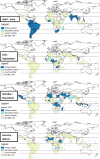Influenza Seasonality in the Tropics and Subtropics - When to Vaccinate?
- PMID: 27119988
- PMCID: PMC4847850
- DOI: 10.1371/journal.pone.0153003
Influenza Seasonality in the Tropics and Subtropics - When to Vaccinate?
Abstract
Background: The timing of the biannual WHO influenza vaccine composition selection and production cycle has been historically directed to the influenza seasonality patterns in the temperate regions of the northern and southern hemispheres. Influenza activity, however, is poorly understood in the tropics with multiple peaks and identifiable year-round activity. The evidence-base needed to take informed decisions on vaccination timing and vaccine formulation is often lacking for the tropics and subtropics. This paper aims to assess influenza seasonality in the tropics and subtropics. It explores geographical grouping of countries into vaccination zones based on optimal timing of influenza vaccination.
Methods: Influenza seasonality was assessed by different analytic approaches (weekly proportion of positive cases, time series analysis, etc.) using FluNet and national surveillance data. In case of discordance in the seasonality assessment, consensus was built through discussions with in-country experts. Countries with similar onset periods of their primary influenza season were grouped into geographical zones.
Results: The number and period of peak activity was ascertained for 70 of the 138 countries in the tropics and subtropics. Thirty-seven countries had one and seventeen countries had two distinct peaks. Countries near the equator had secondary peaks or even identifiable year-round activity. The main influenza season in most of South America and Asia started between April and June. The start of the main season varied widely in Africa (October and December in northern Africa, April and June in Southern Africa and a mixed pattern in tropical Africa). Eight "influenza vaccination zones" (two each in America and Asia, and four in Africa and Middle East) were defined with recommendations for vaccination timing and vaccine formulation. The main limitation of our study is that FluNet and national surveillance data may lack the granularity to detect sub-national variability in seasonality patterns.
Conclusion: Distinct influenza seasonality patterns, though complex, could be ascertained for most countries in the tropics and subtropics using national surveillance data. It may be possible to group countries into zones based on similar recommendations for vaccine timing and formulation.
Conflict of interest statement
Figures




References
-
- Gerdil C (2003) The annual production cycle for influenza vaccine. Vaccine 21: 1776–1779. - PubMed
-
- World Health Organization (2003) Resolution 56.19. Prevention and control of influenza pandemics and annual epidemics. Geneva, Switzerland. 38–40 p.
-
- World Health Organization (2012) Report of the second WHO Consultation on the Global Action Plan for Influenza Vaccines (GAP), Geneva, Switzerland, 12–14 July 2011. Geneva.
-
- Barr IG, McCauley J, Cox N, Daniels R, Engelhardt OG, et al. (2010) Epidemiological, antigenic and genetic characteristics of seasonal influenza A(H1N1), A(H3N2) and B influenza viruses: basis for the WHO recommendation on the composition of influenza vaccines for use in the 2009–2010 Northern Hemisphere season. Vaccine 28: 1156–1167. 10.1016/j.vaccine.2009.11.043 - DOI - PubMed
Publication types
MeSH terms
Substances
Grants and funding
LinkOut - more resources
Full Text Sources
Other Literature Sources
Medical
Miscellaneous

